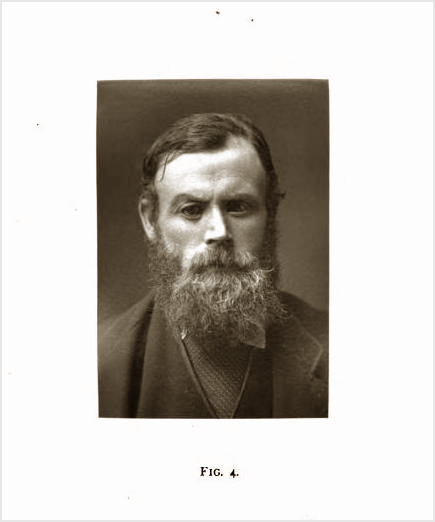
London : J. & A. Churchill, 1884.
Description : [i-vi] p., 7-54 p., advs., [2 l] pl. ; ill.: 2 phots., in-text engrs. ; 8vo.
Photographs : two portraits of clinical subjects, mounted to printed leaves.
Subjects : Eyelid & Conjunctiva — Graft ; Eye — Surgery.
Notes :
There is one question, and that a most essential one, as to the durability of the operation. It is satisfactory to make a conjunctival sac, but how long will it last? Do the surfaces by constant friction tend to adhere? I have just now (November 30, 1883) come across one of the patients whom I exhibited at the Edinburgh meeting mentioned above (p. 9, Case II.), and could not resist the temptation of having his photograph taken (Fig. 4). In his case the conjunctival sac is still as perfect as it was eleven years ago. Both eyes are perfectly good. He has been all the time working at the quarries. The upper and lower lids of the right eye which we had corrected by skin flap from the arm are good and serviceable. It will be seen that in the lower lid the skin, which we had transplanted from the arm, is not only intact, but bears a row of hairs at the border representing the lashes—somewhat abundant, and out of shape to be sure, but still there they are. There was no hair on his forearm when we removed the skin from it (he was then a young man of twenty-two), but now it has grown. The vitality of the transplanted skin-flaps is thus also demonstrated.—Pages 14-15.

The first photograph (Fig. 3) illustrates a chapter on heteroplastic grafting titled, "Transplantation of conjunctiva from the rabbit to the human subject," reprinted with minor revisions from The Practitioner (1884 ; vol. xxxii, no. 1, p. 14-19).
The second photograph (Fig. 4) illustrates the chapter on heteroplastic grafting as well, but rendered into a wood engraving for the original Practitioner article where it was printed with a description of the case. The photograph also serves to illustrate an allograft procedure discussed in the following chapter titled, "On transplantation of skin flaps from distant parts without pedicle," reprinted from a preceding volume of The Practitioner (vol. xxx, 1883).
This second photograph is the subject of Dr. Wolfe's most acclaimed case, Peter Campbell, who was a worker for the Furnace Quarry in Argyleshire. Campbell was 22 years old in January, 1872, when he was injured by a premature detonation of black powder, causing damage to his face and both eyes. Doctor Wolfe began treatments four months after the accident, first with iridectomy, and several months later with transplants of rabbit conjunctival tissue to treat Campbell's symblepharon in his left eye. Wolfe presented the quarrier at the Edinburgh meeting of the British Medical Society in 1873 and published his report in the Glasgow Medical Journal (1873 ; vol. v, p. 200-211 ; vide reprint : »»).
The historic importance of Campbell's portrait derives not from Wolfe's bold writings on heteroplastic grafting, however, but rather for his perfection of full thickness grafting without a pedicle. Wolfe's familiarity with the Reverdin pinch graft led to his observation that only those portions that were seeded without their subjacent areolar tissue proved viable. By the time Peter Campbell returned to the clinic in 1875 for plastic surgery to restore his eyelids, Dr. Wolfe was prepared to test what he had observed. Campbell's right lower eyelid was completely everted and required three sections of a flap lifted from his forearm. Wolfe carefully removed the subcutaneous matter from two of the sections, but left the third section intact, and over the following days it was this third section that suppurated whereas the rest of the flap took hold and revascularized. Doctor Wolfe once again presented Campbell to a meeting of the British Medical Society and published his report in the 1875 volume of the British Medical Journal under the title, "A new method of performing plastic operations" (vol. 2, p. 360-361 ; vide PDF file : »»). With eyesight rekindled, Peter Campbell returned to his job at the quarry. By age 33, when the photograph was taken, traces of his injury could be seen only in the irides and the odd appearance of hair on his transplant.
